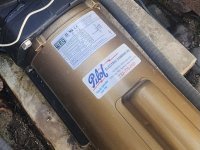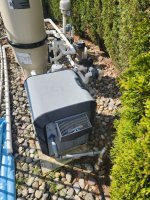Hello, had a 2HP Hayward Super Pump installed and there is an ooze coming from one of the connection points. Anyone know what this is, cause, and potential solution?
Newly installed 2HP Hayward Super Pump
- Thread starter EricLeS1
- Start date
You are using an out of date browser. It may not display this or other websites correctly.
You should upgrade or use an alternative browser.
You should upgrade or use an alternative browser.
- Jun 22, 2014
- 52,015
- Pool Size
- 17888
- Surface
- Fiberglass
- Chlorine
- Salt Water Generator
- SWG Type
- CircuPool RJ-45 Plus
Welcome to TFP!  May I ask who installed this new pump? I ask because not only was the threaded adapter not sealed properly to the pump outlet (pipe dope, Teflon tape, etc), but because there is no union to allow easy removal, the pipe above must be cut somewhere to allow you to unscrew that adapter.
May I ask who installed this new pump? I ask because not only was the threaded adapter not sealed properly to the pump outlet (pipe dope, Teflon tape, etc), but because there is no union to allow easy removal, the pipe above must be cut somewhere to allow you to unscrew that adapter. 
 May I ask who installed this new pump? I ask because not only was the threaded adapter not sealed properly to the pump outlet (pipe dope, Teflon tape, etc), but because there is no union to allow easy removal, the pipe above must be cut somewhere to allow you to unscrew that adapter.
May I ask who installed this new pump? I ask because not only was the threaded adapter not sealed properly to the pump outlet (pipe dope, Teflon tape, etc), but because there is no union to allow easy removal, the pipe above must be cut somewhere to allow you to unscrew that adapter. - May 27, 2021
- 1,278
- Pool Size
- 17000
- Surface
- Fiberglass
- Chlorine
- Salt Water Generator
- SWG Type
- Pentair Intellichlor IC-40
It appears either Rectorseal Tru-Blu or Blue Monster ptfe sealant was used in lieu of Teflon tape on the fitting in addition to a liberal amount of silicone. This practice is unfortunately seen far to often. Water is leaking through the threaded fitting and the sealants and water are creating a gooey mess. Unfortunately to fix, you need to cut connection, install proper high temp unions with o-rings and glue up the rest of the plumbing.
Last edited:
- Jul 21, 2013
- 65,062
- Pool Size
- 35000
- Surface
- Plaster
- Chlorine
- Salt Water Generator
- SWG Type
- Pentair Intellichlor IC-60
Welcome to TFP.
Also, the water temperature sensor is on the pump output pipe. Debris pushed through the pump into the filter can damage the water temperature sensor. The sensor should be installed on the output pipe of the filter.
And wire nutting a connection to the temperature sensor will likely add resistance over time causing incorrect temperatures. Run the wire that comes with the sensor to the panel without a connection. And those wire nuts are not outdoor waterproof.
What is the blue hose in the third picture showing?
Also, the water temperature sensor is on the pump output pipe. Debris pushed through the pump into the filter can damage the water temperature sensor. The sensor should be installed on the output pipe of the filter.
And wire nutting a connection to the temperature sensor will likely add resistance over time causing incorrect temperatures. Run the wire that comes with the sensor to the panel without a connection. And those wire nuts are not outdoor waterproof.
What is the blue hose in the third picture showing?
- Jul 21, 2013
- 65,062
- Pool Size
- 35000
- Surface
- Plaster
- Chlorine
- Salt Water Generator
- SWG Type
- Pentair Intellichlor IC-60
CMP Pool Pump Union 1.5" Male x 1.5" Socket - 21063-150-000 - INYOPools.com
CMP 1.5" MIP, 1.5" Socket (2" Spigot) - 21063-150-000
CMP 2" MPT, 2" Socket Union, Single - 21063-200-000 - INYOPools.com
CMP 2" MPT, 2" Socket Union - 21063-200-000
- May 27, 2021
- 1,278
- Pool Size
- 17000
- Surface
- Fiberglass
- Chlorine
- Salt Water Generator
- SWG Type
- Pentair Intellichlor IC-40
Wow you all rock already! This is my first post here after buying a home with a pool. This replacement pump was installed by a professional (clearly not based on your feedback) who serviced the pool for the previous owners. I've added in some more pictures of the whole setup to help with some of the questions. The blue wire that was asked about looks to be a shared ground between heaters, vacuum pump, filter pump. Pilot electric is just a motor/pump supplier, not the installer.
Attachments
- Jul 21, 2013
- 65,062
- Pool Size
- 35000
- Surface
- Plaster
- Chlorine
- Salt Water Generator
- SWG Type
- Pentair Intellichlor IC-60
This is a Nature 2 mineral system. The minerals it adds include copper and silver, which will accumulate in the water and stain your pool.
Don't replace the mineral cartridge and when you get a chance, remove the canister.

This gas line sediment trap does not look correctly installed.
 www.troublefreepool.com
www.troublefreepool.com
The correct sediment trap design is for the gas to make a 90 degree turn to go into the heater while the sediment can drop down into the sediment trap as shown in the Pentair diagram in the link. We see many gas line installations with the gas going straight and the sediment trap on a 90 degree bend. The sediment will not make that turn and continue into the gas valve eventually causing it to fail.

Tablet chlorinators and gas heaters do not mix well. Especially since it does not look like you have a check valve between the chlorinator output and the heater. The acid in the tablets can flow back into the heater and damage it when the pump is off.
We recommend you remove the tablet feeder and use a SWG to chlorinate your pool.
 www.troublefreepool.com
www.troublefreepool.com

Don't replace the mineral cartridge and when you get a chance, remove the canister.

This gas line sediment trap does not look correctly installed.
Heater Maintenance - Further Reading
The correct sediment trap design is for the gas to make a 90 degree turn to go into the heater while the sediment can drop down into the sediment trap as shown in the Pentair diagram in the link. We see many gas line installations with the gas going straight and the sediment trap on a 90 degree bend. The sediment will not make that turn and continue into the gas valve eventually causing it to fail.
Tablet chlorinators and gas heaters do not mix well. Especially since it does not look like you have a check valve between the chlorinator output and the heater. The acid in the tablets can flow back into the heater and damage it when the pump is off.
We recommend you remove the tablet feeder and use a SWG to chlorinate your pool.
SWG How It Works - Further Reading

- May 27, 2021
- 1,278
- Pool Size
- 17000
- Surface
- Fiberglass
- Chlorine
- Salt Water Generator
- SWG Type
- Pentair Intellichlor IC-40
The drip leg/sediment trap is configured fine. Gas will enter from the top and sediment will be blown into the bottom of the trap, while the gas makes a 90 to the heater. Usually they are configured at the end of the line just before the turn into the appliance. This one isn’t but will work.This gas line sediment trap does not look correctly installed.
The correct sediment trap design is for the gas to make a 90 degree turn to go into the heater while the sediment can drop down into the sediment trap as shown in the Pentair diagram in the link. We see many gas line installations with the gas going straight and the sediment trap on a 90 degree bend. The sediment will not make that turn and continue into the gas valve eventually causing it to fail.Heater Maintenance - Further Reading
www.troublefreepool.com

- May 27, 2021
- 1,278
- Pool Size
- 17000
- Surface
- Fiberglass
- Chlorine
- Salt Water Generator
- SWG Type
- Pentair Intellichlor IC-40
100% agree with this! Here are some recent picture of a thermal regulator and bypass I removed from a 1 year old heater that had been used 1 season (5 months). The feeder also had no check valve allowing acidulated water to flow back into the header of the heat exchanger. The heat exchanger was corroded through and leaking, and the bypass and thermal regulator metal parts were also eaten through.Tablet chlorinators and gas heaters do not mix well. Especially since it does not look like you have a check valve between the chlorinator output and the heater. The acid in the tablets can flow back into the heater and damage it when the pump is off.


- Jul 21, 2013
- 65,062
- Pool Size
- 35000
- Surface
- Plaster
- Chlorine
- Salt Water Generator
- SWG Type
- Pentair Intellichlor IC-60
Yeah, it was unclear to me what was going on in that bend so I wanted to point it out.The drip leg/sediment trap is configured fine. Gas will enter from the top and sediment will be blown into the bottom of the trap, while the gas makes a 90 to the heater. Usually they are configured at the end of the line just before the turn into the appliance. This one isn’t but will work.
View attachment 640971
Similar threads
- Replies
- 6
- Views
- 98
- Replies
- 6
- Views
- 84
- Replies
- 5
- Views
- 288
- Replies
- 33
- Views
- 404











